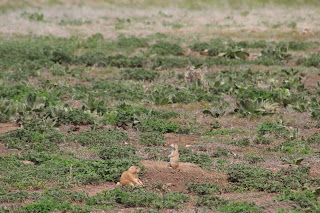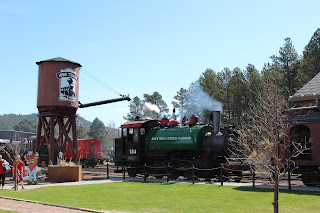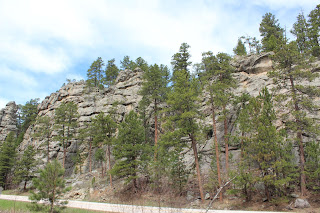I want to do this final post a little different than the previous ones. I'll quickly recount the rest of our trip, and then backtrack a little to our time at Little Bighorn Battlefield National Monument as I believe it is a fitting close to this narrative.
Saturday morning we awoke in Forsyth with fresh spring snow. For those of you wondering, yes it can snow any time of year in Montana. We had a great breakfast with Chuck & Kathy before setting out across the vast openness of Montana to visit Little Bighorn Battlefield. But more on that later.
After our time at Little Bighorn, we made the drive to Bozeman, MT, to stay with my friend Alex, and his new wife Hannah. It was great to visit with them, and it was our second time meeting Hannah. They were nice and treated us to dinner before we spent the evening visiting and playing Ticket to Ride Old West.
The following morning we had breakfast and said goodbye to Alex and Hannah. We stopped by Museum of the Rockies for 3 hours, before making the final drive back to Kalispell and completing our giant 2,000 mile loop.
Little Bighorn Battlefield National Monument
I wasn't sure what to expect when we arrived at Little Bighorn. I had never visited a memorialized battlefield up to this point. We oriented ourselves with some exhibits in the Visitor Center, until the next showing of a film detailing the battle, began. The film does an excellent job portraying an accurate representation of the events leading up to, and during the battle, from both the US Cavalry's perspective, and the perspective of the American Indians.
To me, it seemed ironic to be here after spending a few days enjoying the Black Hills in SD. The different tribes that had been involved in the battle was a final culmination of forcing them to leave their Black Hills home all because of a greed for gold and land.
I think from reading history books about the battle that occurred June 25-26 1876, it is easy to pronounce judgement. And yes, what our American ancestors did was a horrible and inhumane act to the native people already living on North America. There is no arguing that. But if you visit this battlefield, and allow yourself to become fully immersed in what the place shows you, it breaks down those barriers between these two different groups of people. Seeing those exact places where men fell and died painfully is drastically different than reading an account in a book.
Amber and I put on our rain gear and braved the poor weather in an effort to fully experience this memorial. We started off by walking through the US National Cemetery, which houses the remains of our servicemen and women from multiple wars and generations. Then we took our first walk, down the Deep Ravine Trail.
As we hiked down we began passing more and more white marble markers, denoting locations where soldiers fell during the battle. Deep Ravine Trail follows the route of numerous US soldiers who, in an effort to break away from the "Last Stand Hill", were killed.
Reaching the head of Deep Ravine, you are given an unbelievable picture in front of you. Just imagine yourself for a moment hunkering down in this ravine. Overlooking you on all sides stand warriors from the Lakota and Cheyenne tribes. Whatever justification these American soldiers might have felt during the start of the battle was surely erased at this point. You are lying down, fleeing, or fighting in a last ditch effort of survival. Bullets and arrows rain down on you from all sides as you realize you are going to die. You're never going to see your parents, wife, or kids again.
Working our way back up the Deep Ravine Trail, we come to what forever became known around the world as, "Last Stand Hill". Very quickly the fallen soldier markers increase, and General Custer's is marked in black.
There is a monument placed to all those who died during the battle, at the top of the hill.
Across the road is a memorial to all of the different American Indian tribes that took part in the battle, and it gives information and a perspective of events from their side. That part of the battlefield is relatively new, as the Park Service in recent years has taken great strides to correct the historical imbalance that was portrayed in years past. Scattered all over were a different style of markers for those Indians who fell in battle. We didn't take many pictures after this point partly due to the rain and just not being sure what might be considered disrespectful or not.
We then drive a 5 mile road through the park that has numerous pullouts with information and signs depicting different stages in the battle between the US and Indians. All along the way are dozens and dozens of markers. It seems like they would never end.
The other part I want to focus on was at the end of the 5 mile road. This is known as "Reno's battlefield". It was the location of an often overlooked part of the battle, that actually started the chain of events that led to Custer's Last Stand.
The American Indian tribes were encamped in large groups below the bluffs, along the Little Bighorn River. Custer split the forces in half, and Major Reno led the other half. While Custer worked his way around a few miles to flank, Major Reno led the initial attack on the encamped Indians below.
Again, for a moment, imagine what it must have been like for the Indians along the river. It was not only young warriors there. Wives, children, babies, parents, and grandparents were mingled in. You have already watched as your land and way of life have disappeared in the span of a couple generations. And then all of a sudden in the distance you see American soldiers charging down towards the river so they can kill you and your family. What would you do? As terrible and ugly as war is, the Indians had every right to pick up arms and fight against the Americans. In today's world, would it be any different if another foreign power landed on our soil and sought to harm our families and destroy our way of life? Wouldn't you defend your family and friends at any cost?
The Indians thwarted the assault and pushed Major Reno into a retreat. Soldiers from both sides fell along the way, until eventually the survivors struggled atop the hill where the 5 mile road ends. Some of the Indian warriors broke off to attack Custer and start that portion of the battle, while Reno's men were attacked until relief from other military units reached them and the battle concluded. There is a monument at this hill commemorating this portion of the battle.
We spent 3 hours exploring the history and sobering facts of the mentality and way of life the 1800's held, and could easily have spent more if the sour weather had no finally pushed us into moving on. Visiting this place was definitely eye opening and it gives me an appreciation and gratitude that at least now in my lifetime we as a society have realized our wrong from our country's past. While we can never change what happened we can continue to pass on this ugly scars to teach future generations the importance of viewing every human being the way God views each and every one of us. No man is above another no matter their skin color or way of life. When we act in disobedience to God's commands terrible events like the Battle of Little Bighorn occur. These places must continue to be preserved to educate and teach future generations the lessons our ancestors have learned.
"Those who cannot remember the past are condemned to repeat it." ~ George Santayana























































